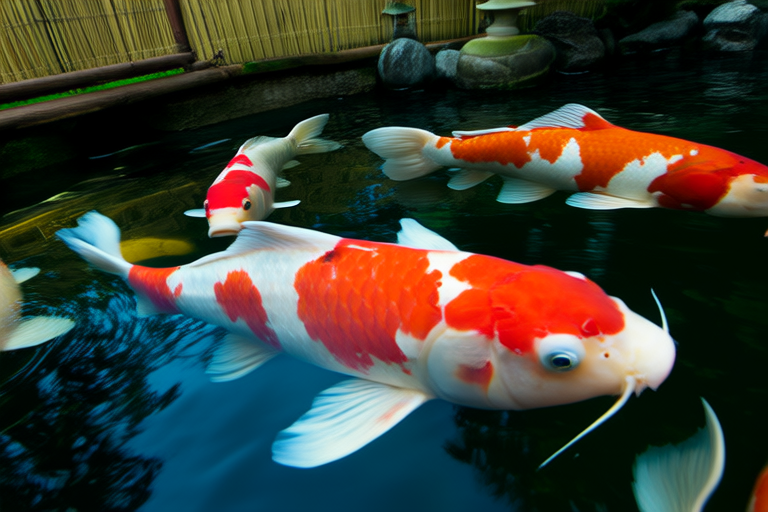Unveiling the Majestic World of Koi: A Complete Guide for Beginners
Welcome to the enchanting world of koi! These vibrant, majestic fish have captivated enthusiasts around the globe for centuries. Koi, or Nishikigoi, are ornamental varieties of common carp that originated in Japan. This guide will introduce you to these fascinating creatures, their history, types, and the essential knowledge needed to set up and maintain a thriving koi pond. Let’s dive into the captivating journey of becoming a koi keeper!
The History and Significance of Koi Fish
The story of koi dates back to ancient China, where they were initially bred for food. Over time, selective breeding led to the development of colorful variations. By the 18th century, koi became popular in Japan as ornamental fish. The term ‘koi’ refers to any one of several color patterns found on these fish. Today, koi are celebrated worldwide for their beauty and resilience.
Koi hold significant cultural importance in Japan. They symbolize good fortune and perseverance, often featured in art and literature. Their presence in a garden pond is believed to bring peace and tranquility to the surroundings. As you embark on your koi-keeping journey, you’ll not only enjoy the aesthetic pleasure but also gain a deeper appreciation for this rich heritage.
Different Types of Koi and Their Characteristics
Koi come in various breeds, each distinguished by unique color patterns and markings. Here’s a closer look at some of the most popular types:
- Red Koi (Hi Utsuri): Known for their striking red bodies with black markings. These koi are highly sought after for their bold appearance.
- Black Koi (Kohaku): Characterized by their white bodies with red markings. Kohaku are admired for their elegant simplicity.
- Blue Koi (Shiro Utsuri): Featuring black and white patterns, blue koi are known for their graceful elegance.
- Yellow Koi (Ogon): Displaying a metallic sheen, yellow koi are cherished for their shimmering appearance.
Each type of koi has its own charm and beauty, making it exciting to choose which ones to add to your pond. As you become more familiar with koi, you’ll notice subtle differences in their patterns and personalities, adding depth to your experience.
Setting Up and Maintaining a Koi Pond
Filtration Systems
A well-functioning filtration system is crucial for maintaining clean, healthy water in your koi pond. There are three main types of filters:
- Mechanical Filters: Remove debris like leaves and uneaten food from the water.
- Biological Filters: Host beneficial bacteria that break down harmful waste products.
- Chemical Filters: Absorb toxins and excess nutrients from the water.
Combining these filter types ensures optimal water quality, creating a safe environment for your koi to thrive.
Water Quality
Regular testing and maintenance of water parameters are vital. Key factors include:
- pH Levels: Should ideally be between 7.2 and 8.5.
- Ammonia and Nitrite Levels: Should be undetectable.
- Nitrate Levels: Should remain below 50 ppm.
Investing in a reliable water testing kit will help you monitor these parameters and make necessary adjustments to keep your koi healthy.
Temperature Control
Koi are cold-water fish and can tolerate temperatures ranging from 40°F to 85°F. However, maintaining a stable temperature within this range is important for their overall well-being. Extreme temperature fluctuations can stress the fish and lead to health issues.
To control temperature, consider installing a heater for colder months and a chiller during hot summer days. Additionally, providing ample shade and maintaining a large volume of water in your pond can help stabilize temperature changes.
Proper Feeding Habits
Feeding koi is both enjoyable and essential for their health. Choose high-quality, nutrient-rich foods specifically formulated for koi. Feed them small amounts multiple times a day, especially during warmer months when they are more active. Adjust feeding frequency based on water temperature and fish activity levels.
During colder periods, reduce feeding to once daily or even less frequently. Avoid overfeeding, as excess food can pollute the water and harm the fish. Always observe your koi’s behavior and adjust feeding accordingly.
Common Health Issues and Prevention
Despite their hardiness, koi can face health challenges. Regular monitoring and prompt action can prevent many issues:
- Fungal Infections: Look for cotton-like growths on the skin. Treat with antifungal medications.
- Bacterial Infections: Symptoms include fin rot and ulcers. Use antibacterial treatments under professional guidance.
- Parasites: Visible parasites can cause irritation and damage. Consult a veterinarian for appropriate treatments.
Preventive measures include maintaining excellent water quality, providing a balanced diet, and minimizing stress through proper handling and habitat management.
Enjoying and Caring for Koi Long-Term
Caring for koi is a rewarding endeavor that offers numerous benefits. Watching these beautiful fish gracefully swim in your pond can provide immense joy and relaxation. Establishing a routine for feeding, cleaning, and monitoring water conditions helps ensure the longevity and well-being of your koi.
As you grow more experienced, you may want to explore breeding koi or participating in local koi shows. These activities offer opportunities to connect with fellow enthusiasts and deepen your understanding of koi care.
Remember, the key to successful koi keeping lies in dedication and attentiveness. With proper care and attention, you can enjoy the beauty and serenity of koi for years to come.
